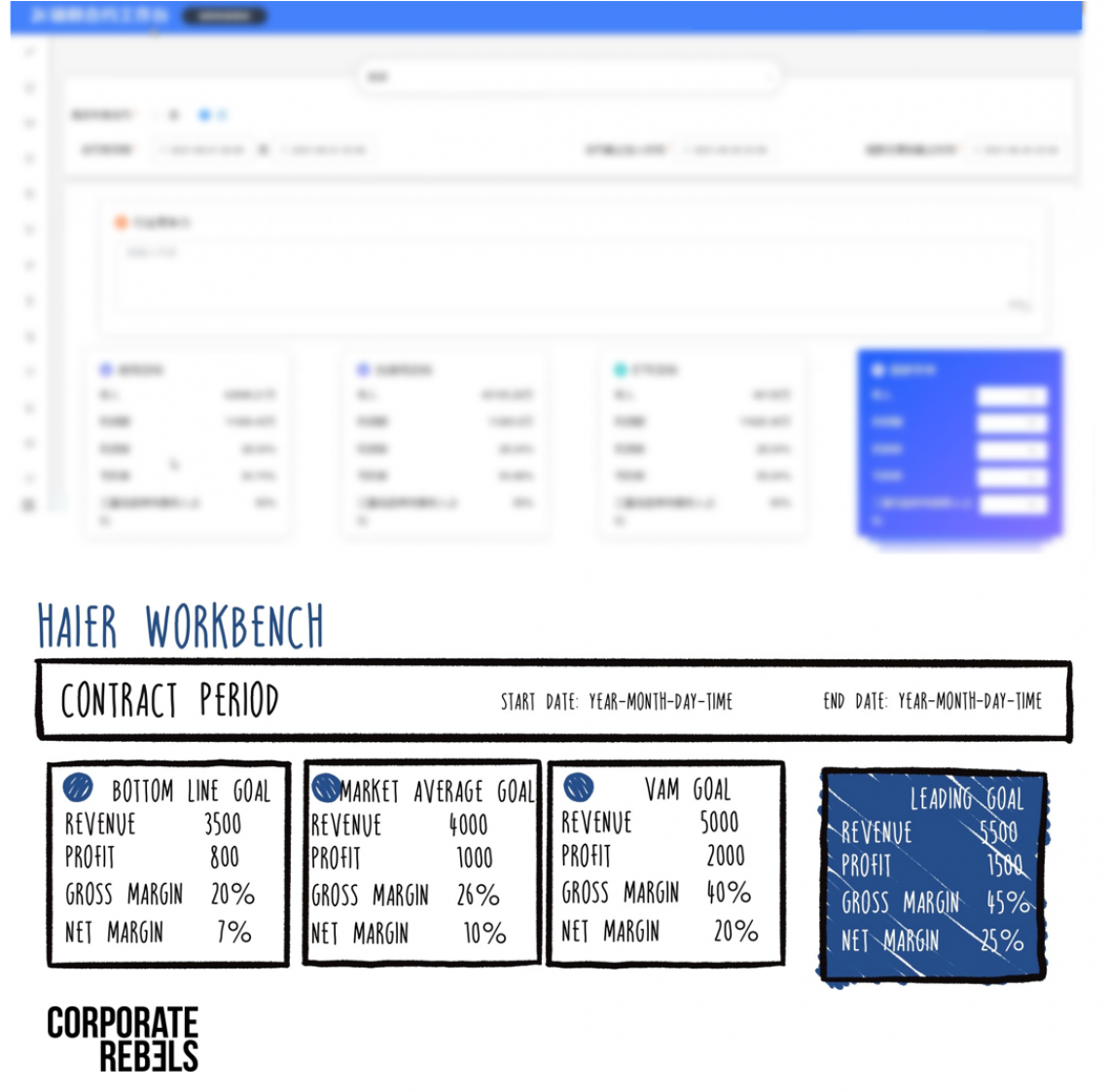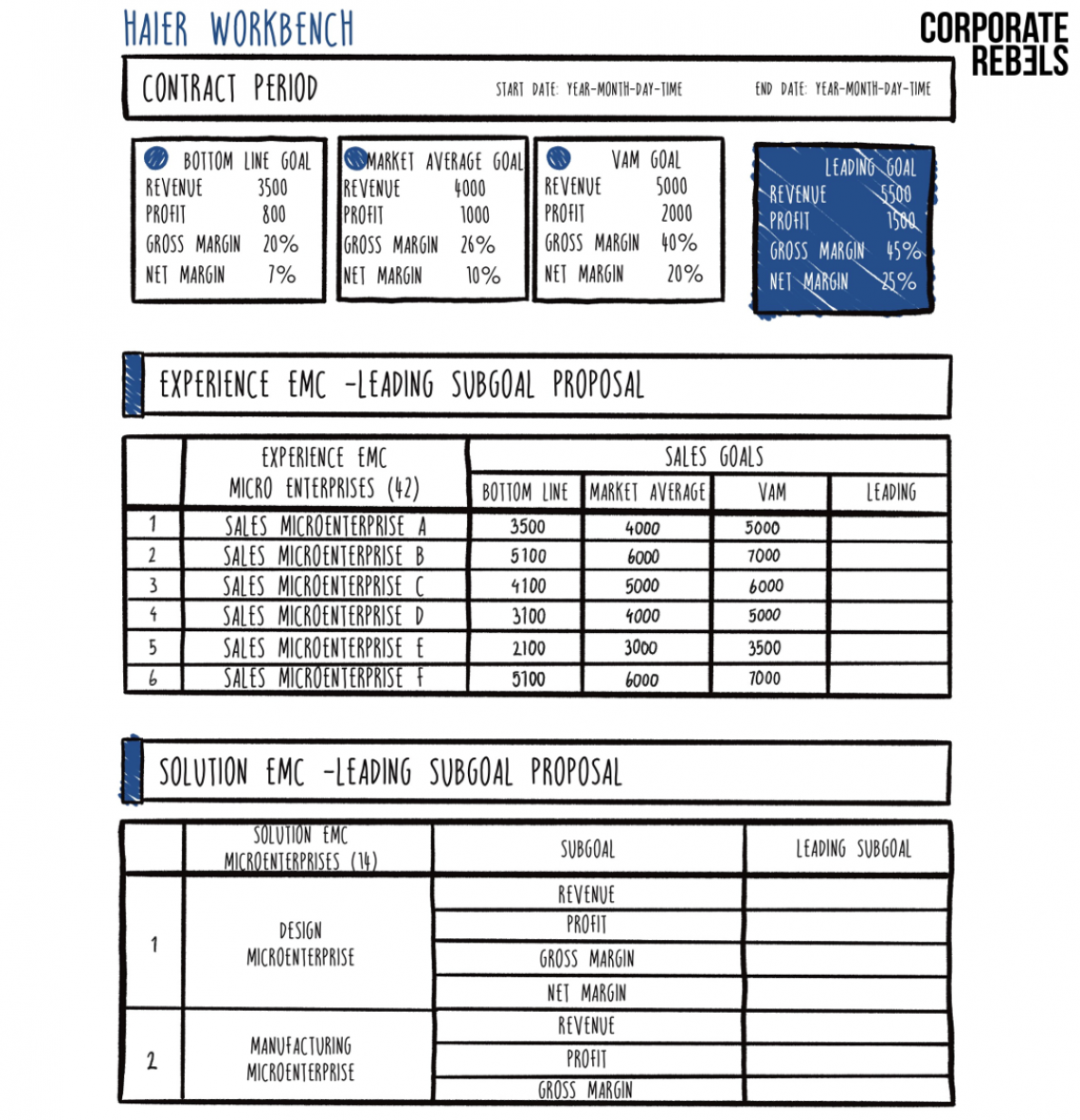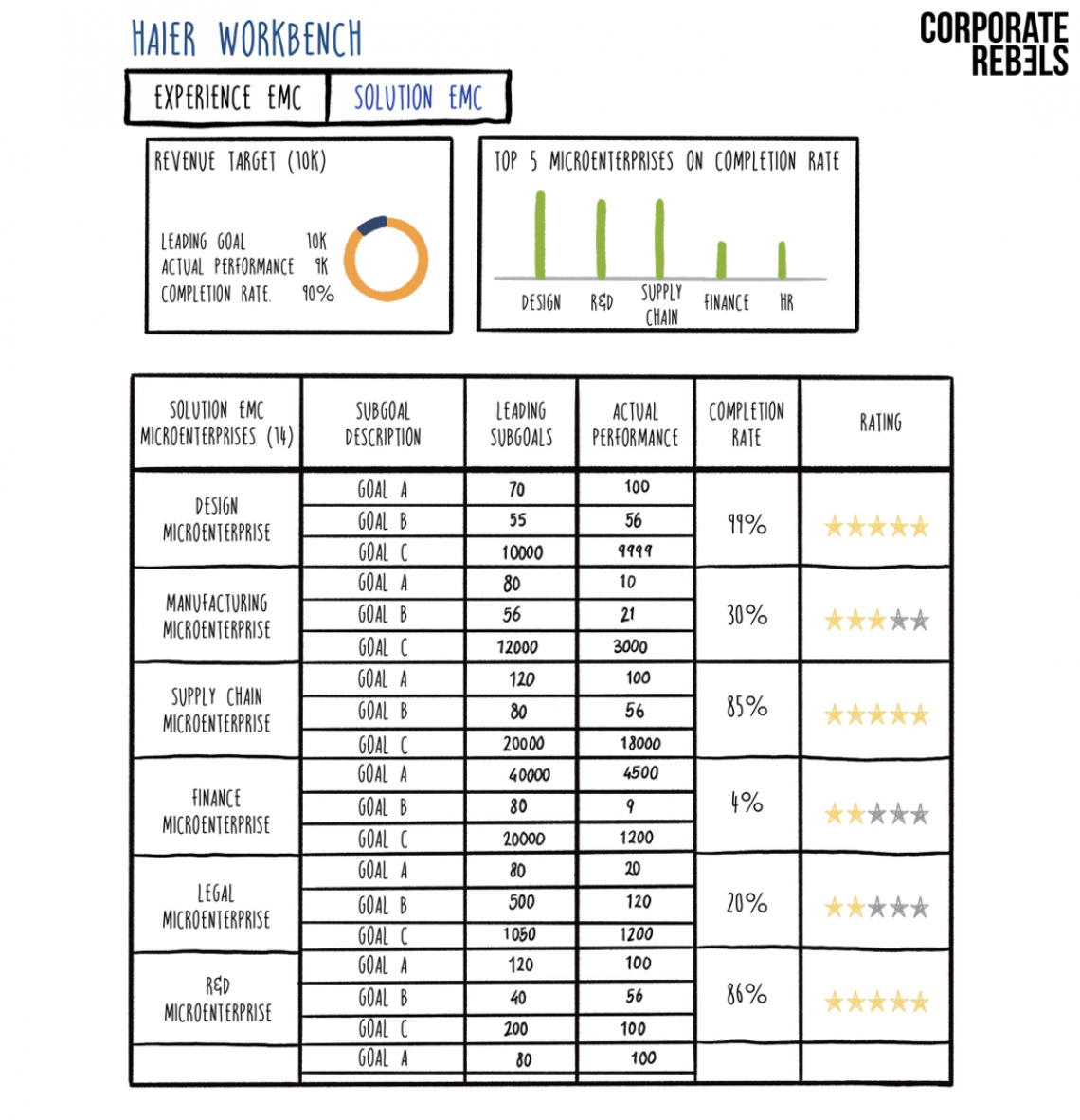Organizing Based On Algorithms And Smart Contracts

In early 2019 Haier introduced the organizational concept of so-called EMCs. The concept enabled its radically decentralized teams to form temporary alliances with others (and external partners), in order to jointly deliver 'smart products & services' to its customers. It, however, also spiked internal transaction costs tremendously. To fight this problem Haier developed its own internal digital tool dubbed as the “Workbench." This tool relies on algorithms, smart contracts, and blockchain technology to make the whole greater than the sum of its parts.
Animation
Have you never heard of Haier? Or it's organizational model called Rendanheyi? Then please watch this animation first, before you read on.
High transaction costs
In the animation we talk mostly about how Ecosystem Micro-Communities (EMCs) allow Haier's Micro-Enterprises (MEs) to collaborate with each to other to be able to unleash impressive levels of entrepreneurship of its members.
We explain how the coordination and collaboration efforts of different MEs and EMCs is guided by internal market mechanisms based on an elaborate system of goals (or targets), bidding procedures (or tenders), and contracts.
During the introduction of EMCs, in 2019, these internal market mechanisms relied mainly on members conversing with each other during offline meetings.
During these meetings, data from different individuals and MEs were brought together so everyone could be provided with a shared picture of all priorities, members' roles and goals, and individual contributions and performances.
These meetings were necessary to ensure that everyone within the different MEs and EMCs shared the same information. They were also needed because MEs (and external partners) had to sign contracts with each other—on paper.
The heavy reliance on offline meetings and paper-based contracts was not without problems. It was not only a cause of high transaction costs, it was also hard for people to see real-time performance of themselves and others.
The introduction of a digital tool called the Workbench changed all of this.
Haier's Workbench
In December 2019, Haier's IT team (a total of 400 people, of which 50 were dedicated to the Workbench) set out to drastically reduce their internal transaction costs by completely digitalizing their internal market mechanism.
The Workbench allows MEs to now self-organize in a wholly digital manner. It took over many collaboration and coordination efforts that previously occurred during the offline meetings, such as initiating contracts, breaking down tasks into smaller sub-tasks, aligning tasks, performance monitoring, information sharing, reward distribution, and providing feedback.
The tool consists of three main areas:
1. A digital internal marketplace
The digital internal marketplace is where people can propose and bid on goals, along with signing and updating contracts.
The tool automatically facilitates the bidding process and generates profit-sharing proposals between the different MEs and other partners in their respective EMCs.
It also facilitates the EMC contracting process, as this is the place where template-based EMC contracts are digitally initiated, created, signed, and periodically updated.
2. A digital performance dashboard
The digital dashboard shows the real-time performance of individuals, MEs, and EMCs.
The tool automatically breaks larger goals into monthly, weekly, and daily tasks. It then evaluates the performance of people, MEs, and EMCs on reaching their tasks and goals. It also generates real-time data about individual, MEs, and EMCs performance and visualizes it in performance comparison tables.
The tool then automatically generates profit-sharing percentages (Haier calls this value-added sharing) and monthly payments based on real-time performance comparison tables.
3. A digital communication channel
The digital communication channel is where anyone can communicate with anybody else within the Haier ecosystem.
The tool enables fast and direct interaction between MEs/EMCs, their external partners, and even with their customers. It also allows MEs to communicate directly with all their stakeholders so they can efficiently self-organize to satisfy the demands and needs of their customers.
Let’s take a deeper look into the digital marketplace and the digital performance dashboard as these are the ones that rely the most on algorithms, smart contracts, and blockchain technology.
Digital marketplace
Let’s zoom in on three fundamental activities that take place in the internal marketplace: bidding, performance tracking, and profit-sharing.
1. Bidding
Before EMCs were introduced at Haier, MEs that worked together had to sign separate contracts with each other. This led to a complex web of agreements.
The introduction of EMCs and the Workbench simplified this complex contract environment.
Now, all ME and other partners that participate in an EMC must sign just one collective EMC contract in the Workbench, thereby removing the need for a complex web of contracts.
However, before any ME is able to become part of a EMC, they must first engage in the digital bidding process facilitated by the Workbench.
The bidding process is structured around four different goals:
- Market Average Goals
- Bottom Line Goals
- VAM Goals
- Leading Goals
The image below shows how the four different goals are visualized in the Workbench.

On top of the image is a screenshot of the real Workbench (in Mandarin) that is blurred for confidential reasons. Below, you’ll find a simplified and translated sketch of the same screenshot.
Market Average Goals
All of Haier’s goals can eventually be traced back to so-called Market Average Goals. As the name implies, these goals represent the average market performance of products and services.
Each month, EMCs calculate these goals with the help of the Workbench's algorithms that tap into historical sales data and average market data of competitors. (The tool is designed to try to connect all the active databases within Haier.)
In addition, Haier also asks all its 42 sales MEs located throughout China to set monthly sales targets for their own dedicated geographical areas they are responsible for—because they know their customer best.
All these separate sales targets, as set by the sales MEs, are then automatically collected and aggregated by the Workbench. When the monthly aggregated goal set by the sales MEs turns out to be higher than the monthly goal set by the EMC, the goal becomes the Market Average Goal of that particular month.
Bottom Line Goals
The Bottom Line Goals represent the minimum goals EMCs must aim to reach. These are automatically generated by the algorithm of the Workbench.
Market Average Goals are the benchmark to calculate the Bottom Line Goals, which are often set at 70% of the average market performance.
VAM Goals
The VAM Goals represent the actual goals MEs set themselves, and represent the goals that are set by the MEs with the winning bids.
Reaching these goals means that EMCs become eligible for future profit-sharing rewards as agreed in the EMC contract.
Leading Goals
When an EMC bids for a goal, in addition to set a VAM Goal, it can also set a Leading Goal. The Leading Goal should always be higher than the VAM Goal.
Leading Goals are based on an internal principle called "higher value added, higher sharing". This means that MEs/EMCs that achieve their Leading Goals will be eligible for higher profit-sharing rewards.
Due to Haier's internal competitive market dynamics, only the MEs that win the biddings are awarded a place in the respective EMC.
In each EMC, there are two kinds of biddings:
- Biddings for EMC leader positions
- Biddings for EMC member positions
Biddings for EMC leader positions
Here, a bidding process between different ME leaders takes place to determine the EMC leader. This process can be regarded as an ordinary tender process.
The ME leader with the highest bid is rewarded with the EMC leadership position. At that moment, the winning bid is turned into the goals (including the VAM Goal and Leading Goal) for the entire EMC.
Note: Winning bids must always be higher than the Market Average Goals.
Biddings for EMC member position
Once the EMC leader is identified, one of the first things they will do is to start a tendering process (through the Workbench) around sub-goals (based on the Bottom Line Goal) that the leader sets .
After releasing the tender, everyone is able to see the new opportunities. MEs and external partners are invited to bid competitively on the specific sub-goals and, as such, become a member in the respective EMC.
Note: Every EMC must include a finance ME, an HR ME, and a legal ME. They ensure that all things related to accounting, HR, and legal are properly done.
The image below shows how this process is visualized in the Workbench.

Again, only the MEs and external partners that have the highest bids are awarded a place in the EMC. But they all have to be mindful about their biddings: They must bid high enough to get a place in the EMC, but they also take a risk when overbidding.
If they can’t deliver on their promise that is detailed in the EMC contract, they are essentially “punished” by compromising their credibility (credibility in Haier is measured by a credit score based on a star system, but we’ll go into that later on).
This is important because you will be disadvantaged in future bids if your credit score is too low.
To give you a sense of scope: each month there are more than 4,000 bids made through the Workbench, of which 100 are successfully turned into new EMC contracts.
2. Performance tracking
When the leader and members of the EMC are identified based on their winning bids, it becomes time for the next step: the EMC contract.
The EMC contract is automatically generated by the Workbench after all parties in the EMC agree with the terms of collaboration. These are so-called smart contracts stored in blockchains (Ethereum) to create increased transparency around the contracts.
Smart contracts can be seen as self-executing agreements in which a chain of actions are triggered when certain conditions are met. Through the Workbench these contracts are automatically enforced and cannot be fiddled with.
During the duration of the contract, the Workbench breaks down the goals and sub-goals via detailed daily activities and deliverables for all members that are part of the EMC.
The tool also tracks the daily performance of the members compared to their respective deliverables. This allows all members in the EMC to easily and rapidly spot any differences that arise between planned and actual performance.
As such, the Workbench makes the process of real-time performance tracking transparent to all members in the EMC. The image below shows how this is visualized in the Workbench.

As shown in the image, the level of performance of the members in the EMC is made visible by a star system.
This star system is the basis of the actual profit-sharing schemes that will be activated once the EMC reaches its goals.
3. Profit sharing (or value-added sharing)
Profit-sharing is an important part of Haier's remuneration system, which is built around performance (the value added for the customer) and around the Chinese concept of common prosperity.
As a result, the profit-sharing mechanism of Haier tries to enable the firm both to make the cake bigger and divide the cake fairly among all stakeholders—a contrast to traditional workplaces that typically only seek to make their cake bigger to maximize profits for its shareholders.
That is why each month EMCs propose potential future profit-sharing percentages for each member in their EMC based on their actual contributions.
The image below shows how this process is visualized in the Workbench. (For example, 20% of the profit will go to the design ME in the EMC).

ME leaders engage in a similar profit-sharing proposal process for the teams and individuals that are part of their respective ME.
For example, as you can see in the image above, of the 20% profit share for the design ME, 3% is allocated for Team A (within the design ME), 7% is allocated to Individual B, and the last 10% will go to Team C.
These smart contracts run on blockchain technology and play an essential role in the profit-sharing process. For example, once the design ME has done its work, it can retain a stake in the future sales of that work by placing a code into the smart contract that automatically grants the design ME 10% of any transaction value. The ME can also code the smart contract to distribute certain percentages of that value to specific teams.
As such, all EMC partners can alter conditions in a smart contract as long as they find consensus with each other—and it can happen without intermediates.
Learn more
Haier launched its first EMC only in early 2019, and the Workbench in late 2019. It turned out to be a success. Now, more than two years later, more than 400 EMCs have organically emerged throughout the entire organization.
Want to learn more about how you can boost similar levels of entrepreneurship in your own company? Then check out our on-demand course about Haier and other progressive organizations and practices at our Corporate Rebels Academy.

